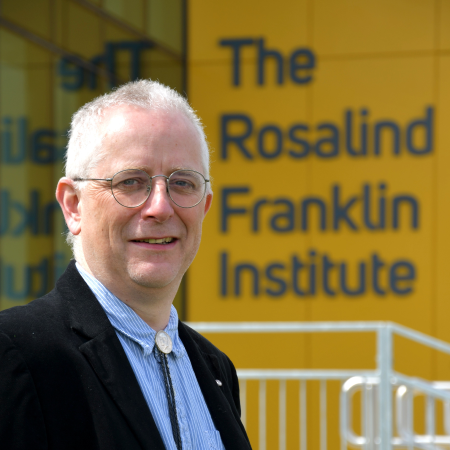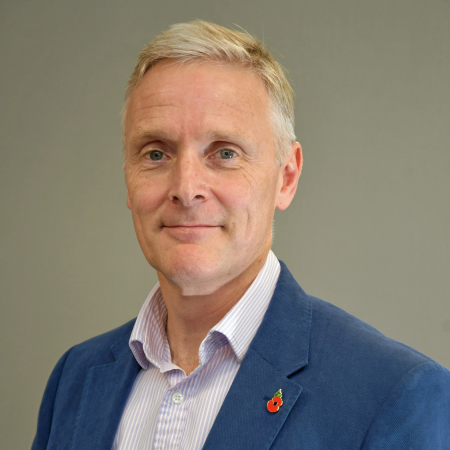Reaching Factor Of 10 Impact On Health Care Innovation
Exploring The UK’s Rosalind Franklin Institute
Executive Summary
Funded by the UK government, The Rosalind Franklin Institute works with industrial and academic partners from across the UK to foster interdisciplinary research with “real impact.” Leaders from the growing institute talk to In Vivo about validating its success and what it means to seek truly ground-breaking innovation in 2021.
Only three years old, the Rosalind Franklin Institute in the UK has big plans to go after transformative technologies in health care, using a “factor of 10” principle to measure its success.
James Naismith, director of the Franklin as well as head of its structural biology team, told In Vivo that groups at the institute are trying to build things that have never existed before. “We should be doing things where there's a realistic prospect of failure,” Naismith said. “Where we succeed, you shouldn't need me to explain that we've succeeded. It should be clear because it's a fact of changing from where we were before.”
Naismith cited the Franklin’s correlated imaging group as an example of this level of novelty and innovation. The group is focused on developing better cryo-ptycho-tomography processes and solutions, for greater quality 3D imaging that is easier and faster to use.
Technology At The Franklin
The Rosalind Franklin Institute, established in 2018 with UK government funding, is focused on bringing transformative changes to the life sciences through interdisciplinary research and technology development. The Franklin has constructed itself around five themes, which make up its core teams:
-
Artificial intelligence and informatics group, led by Mark Basham
-
Biological mass spectrometry group, led by Josephine Bunch and Zoltan Takats
-
Correlated imaging group, led by Angus Kirkland
-
Next-generation chemistry group, led by Ben Davis
-
Structural biology group, led by James Naismith
The institute hopes that progress in these five areas will allow innovators to see the biological world in new ways, moving from single molecules to entire systems.
Located at the Harwell Science and Innovation Campus in Oxfordshire, the group is named in honor of Rosalind Elsie Franklin (25 July 1920 – 16 April 1958), an English chemist and X-ray crystallographer whose work was central to the understanding of the molecular structures of DNA, RNA and viruses. It was formed by a group of 10 university partners from across the UK, alongside Diamond Light Source and UK Research and Innovation’s Science and Technology Facilities Council (UKRI-STFC).
The heart of the Rosalind Franklin Institute is a new hub building located at Harwell. The 5300m2 building is a flagship new addition to the campus, complementing existing facilities.
Naismith said tomography was still overly artisanal and at an “incredibly skilled and difficult stage.” He wants the Franklin to be “a big part of trying to shift it from where things are today … so that it becomes a routine, powerful technique that year-on-year gets better, faster and quicker.” He wants the institute to be able to “take away some of the bits that cause many, many tomography projects to fail.” For example, issues with handling samples, “because you have to move them from machine to machine to machine.”
His group is working with Thermo Fisher Scientific on designing a new workflow that can be automated. “At the moment, tomography processing is a highly skilled task, it takes scientists a significant amount of time. But we can teach machines to do some of these tasks,” Naismith said.
Naismith noted that while AI and machine learning were born out of academic labs, there use is more popular in commercial areas. “Of course, [their] application is dominated by where there is money and funding, and there's been less of that for true science-based projects and much more for commercial security service type approaches.”
Factor Of 10
The Franklin draws from its leadership team and scientific advisory board to guide on which areas of research are truly distinctive and bold for the institute. “We have this rule of thumb ‘factor of 10’ guide,” chief operating officer Paul McCubbin told In Vivo. “The researchers ask, ‘If a particular research project is successful, will it have a factor of 10 impact on the utility of the outcome?’” For example, McCubbin suggested technologies that could increase the volume of material that can be imaged by a factor of 10.
The group uses this rule to help it “steer away from incremental research,” he said.
Not all of the projects started at the Franklin will reach that factor of 10 goal. For programs achieving incremental benefits, McCubbin said the question would become, ‘Is this better placed somewhere else?’ In those cases, “we might partner with somebody, either with another academic institute or indeed with industry. If we've tried it, and it doesn't get to that factor of 10, then that's the point at which we should be challenging ourselves to say, ‘Maybe this is no longer a Franklin project, it's time to move on to another.’” He said the group aimed to be very disciplined in the projects it continued, only seeking those which would provide true change for health care and society.
Collaboration With Industry
“Excellence in science is at the forefront of everything we do,” said McCubbin. One of the measures for this was external validation, he noted, whether that was attracting funding from other sources or collaborating with companies in the life sciences sector. The Franklin wants to see other companies investing alongside the institute in the development of technologies in its portfolio. “We're still early in our evolution. But over time, I would hope we could broaden the scope of our collaborations around joint funding of research to ones that have more of a commercial focus, so licensing technologies, or maybe even spinning out companies,” he explained.
Part of the remit for the launch of the institute is to contribute to the overall life sciences sector in the UK. “The driver is the science, but the benefits of that science are measured by the impact on society, and the economy is a key part of the longer-term goal,” McCubbin said.
Strength Of UK Science
McCubbin highlighted as an asset for the Franklin the strength of science in the UK, and particularly the region’s history in developing imaging technologies.
“There's a strong foundation in the UK, but also a recognition of the need to continuously look at different ways of achieving innovation,” he said. The UK government also works with establishments like the Francis Crick Institute and the Wellcome Sanger Institute. And while there is a very strong medtech cluster in the UK and Ireland, these markets must not “rest on their laurels but instead try different approaches to maintain that innovative edge,” McCubbin said.
The COVID Effect
The Franklin’s leaders hope for a positive outcome from the COVID-19 pandemic when it comes to the strength of scientific research. “In a broader context, I hope that what has happened with vaccines will strengthen the credibility of science more broadly in society,” McCubbin said. “Science is the way out of this pandemic.” He added that the global COVID-19 vaccine development programs show “what can be achieved with the right technologies and the right motivation. It's been a dreadful experience, but hopefully, in terms of the public standing of science, there will be some benefits to come out of this.”
Over the past year, the level of investment and commitment to biopharma research has increased. McCubbin said this was not just the picture within academia and industry, but also with regulators. “I think there's been more of a focus to try and find ways of accelerating development,” he noted. While rapid development and approval processes seen for COVID-19 vaccines and therapeutics are unlikely to be repeated for every drug, the hope is that the pandemic will reveal lessons to take away from 2020. “Will it change everything? I suspect not. But there are probably some lessons that would benefit R&D more broadly.”
 Jim Naismith
The Rosalind Franklin Institute
Jim Naismith
The Rosalind Franklin Institute
Naismith noted that he had seen a change in how people were thinking about science and health care, in part driven by the COVID-19 pandemic. “Tomography has not been brought to bear in COVID in real time. That's in part because it's technically difficult to handle such infectious material. But structural biology has made a huge impact on COVID-19. And we know that tomography has the potential to have an even bigger impact on these types of diseases,” he explained. “If we hadn't developed structural biology to the extent we had, we would have struggled to interpret a lot of the mutations that we saw in the virus’s structural biology. We know why these mutations appear, what they do … we've used them in terms of targeting nanobodies. And all of that is enabled by the technology that has come from structural biology.”
The COVID-19 pandemic has also served to highlight the importance of home-born research for governments all over the globe. McCubbin said he was encouraged by the UK government’s aspirations to maintain science funding, including a recently launched model that allows research groups to access larger pots of money for “bolder initiatives over longer timescales.”
As part of government plans to cement the UK’s position as a “global science superpower,” the newly formed Advanced Research & Invention Agency (ARIA) will be tasked with funding high risk research that offers the chance of high rewards. ARIA, announced in February 2021, has access to £800m in government funding to invest in “the most inspiring inventors” and help them turn their transformational ideas into new technologies, discoveries, products and services. The model is similar to the Advanced Research Projects Agency (ARPA) in the US.
Naismith noted that the ARIA model offered researchers more freedom, which is needed for truly innovative projects that take time to evolve – and that might not succeed. “The tomography project [at the Franklin] is really at the blue-sky level: it might not work,” he noted as an example. “Also, some of our colleagues working in mass spectrometry are trying to build a machine that's never existed. So that is incredibly high risk.”
As well as ARIA, McCubbin noted the Wellcome Trust’s new Leap Initiative, which he said was trying to cut through a lot of the bureaucracy that surrounds research and innovation within the university environment.
Wellcome Leap is a US-based non-profit organization founded by the Wellcome Trust to accelerate innovations that benefit global health. In January 2021, it announced the first 21 participants in the Leap Health Breakthrough Network, “a global group of leading academic and research institutions committed to solving the world’s most serious health challenges — such as cancer and infectious diseases — at record speed.” The first charter signatories include California Institute of Technology, Francis Crick Institute, Massachusetts Institute of Technology, National University of Singapore, University of California, Los Angeles, University of São Paulo and Wellcome Sanger Institute, among others.
 Paul McCubbin
The Rosalind Franklin Institute
Paul McCubbin
The Rosalind Franklin Institute
Participants in the Leap Health Breakthrough Network, as well as commercial partners, will help to build and execute bold, unconventional programs, funded at scale. This includes efforts such as the $50m Human Organs, Physiology, and Engineering (HOPE) program, announced in late 2020.
“I’m optimistic that some of the traditional barriers around taking the results of research and having the freedom to test that in the market will be addressed by some of these initiatives,” McCubbin said. He added that the Franklin aimed to be easy to work with. “In terms of engaging with industry, we aim to be very clear on what we're looking for, and relatively straightforward to negotiate with as well.”
Attracting Talent For Growth
Moving beyond the pandemic, the Franklin Institute is entering a period of growth. Being able to attract the right talent is critical for the group’s success. “We've got some big competitors for science researchers right on our doorstep,” McCubbin said. “Being able to attract talent here is important. We are very encouraged by the government's commitment to talent visas, etc. to allow that to happen. So far, we are still able to recruit for the key roles that we're seeking to fill, and we want to make sure that continues.”
Although the Franklin is a relatively small institute, it is seeking talent across a broad spectrum, from software engineers to chemists, biologists and physicists. “It's quite an eclectic mix of scientists because the focus is on collaboration; taking basic technology and applying it to life sciences,” McCubbin said.
Thinking about the role of the Franklin in the global life sciences market, McCubbin said, “You can't ignore what's going on beyond the UK and will be judged by reference to your peer group wherever they might be situated.”
As the Franklin matures, it wants to deliver factor of 10 scientific breakthroughs validated by its ability to work with a wide range of collaborators. COVID-19 has served to highlight the strength of combining academic, research and industry groups around a common goal.
